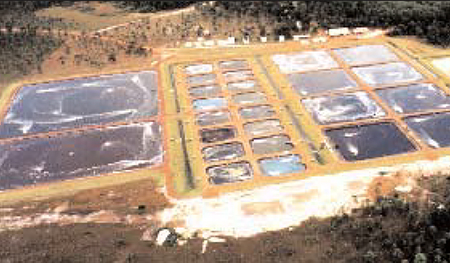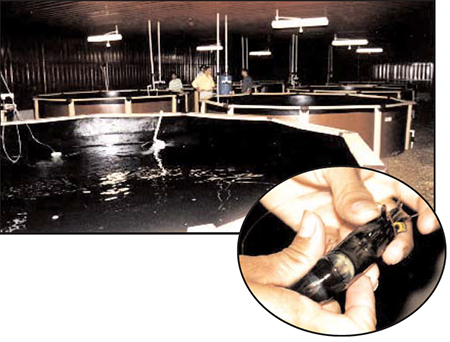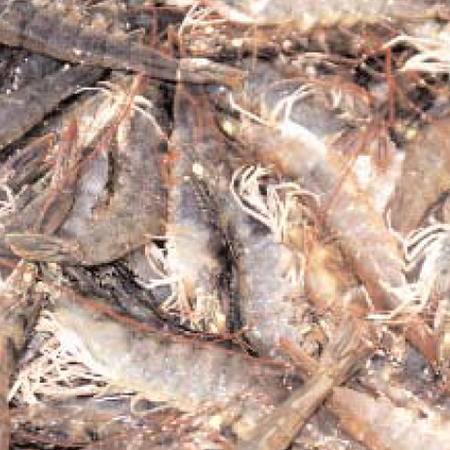Philosophy of Belize Aquaculure Ltd.

There is much debate about which trait is more important to the grower, disease resistance or growth rate. The philosophy of Belize Aquaculture Ltd. (BAL) from the very beginning has been to concentrate on using clean animals that perform well at the high densities and high nutrient loads associated with intensive, zero-water-exchange culture strategies.
Once the species was identified, several strains were selected and a farm-based breeding program initiated to enhance performance characteristics of the stock. BAL made the commitment to utilize only specific-pathogenfree stocks (SPF), and to develop a culture system that prevents the entry of viruses through a strict biosecurity program. This approach was chosen to eliminate the necessity of developing new strains of shrimp that are resistant to new viruses that seem to emerge every few years. It allowed BAL to focus its attention on the important performance categories of growth and pond survival in a farm-based breeding program.
Results to date have supported the approach of using clean animals that perform well at high density using zero water exchange. This is reflected in a continuing tend of increasing farm yields, and more specifically, in improvements in growth and survival rates. In this article, we will review the major features of the BAL biosecurity, breeding and larviculture programs, and our results for the first two years of operations.
Biosecurity program
Once the decision was made to use only SPF stocks; it was necessary to implement a biosecurity program to minimize the chances of a shrimp pathogen entering the culture facility. Most viral pathogens enter shrimp farming facilities through the introduction of infected livestock or through the introduction of water that carries either a viable viral particle, or an active or passive biological carrier of the virus. Other mechanisms for viral introductions would include the passive entry of a virus on the shoe of an individual, by birds dropping infected feces into a pond, or by insects either actively or passively carrying a virus between farms.
Much of our biosecurity program involves a common sense approach. The first line of defense is ensuring that Belize stays free of the major shrimp viral pathogens such as TSV and WSSV. Recently the Belize Shrimp Growers Association adopted a policy of only importing verifiable SPF stocks into the country up to the point where the country can produce sufficient seed stock to meet all the farms needs. Belize should attain self-sufficiency in shrimp seed during the year 2000, at which time the country would close all borders to further importation of seed. By maintaining Belize free of major pathogens, the possibility of the entry of pathogens via livestock, water, biological carriers, birds, and insects is for all practical purposes eliminated.
BAL defined SPF shrimp, as shrimp from facilities that could demonstrate a clear history of being free of the major shrimp pathogens; IHHNV, TSV, WSSV, YHV, HPV, and baculovirus. During the phase when we were importing our initial stocks, it was learned that a facility that had sent us 400 broodstock, had just tested positive for IHHNV. The infected shrimp had come from tanks not associated with the tanks that held the broodstock we received, but nevertheless the facility no longer showed a history of being free of virus. All broodstock that had been received from that facility were destroyed on the suspicion that there was the slightest chance that the stock we received was infected with IHHNV. Since the original importation of three strains of L. vannamei and one strain of L. stylirostris in 1997, BAL has not imported shrimp livestock.
BAL is built at an elevation of between 18 and 22 feet above sea level, and the estuary is at least 1000 meters from the nearest pond. Water is pumped from the Caribbean Sea, 3 km distance from the farm into one of two reservoirs. Initially water was filtered through a 250-micron sock filter; but recently the sock filter has been reduced to 185 micron. By being somewhat isolated from the coastal zone, and filtering all water through a 185-micron filter, most potential viral carriers are eliminated from the culture system. If it were determined that WSSV had infected local populations of crustaceans, then all water entering the farm could be chlorinated seaside, and by rotating the two reservoirs, de-chlorinated before being pumped into ponds. Water treatment such as chlorination at doses sufficient to kill all viral particles and carriers is possible with zero exchange systems, and this option presents BAL with an insurance option if ever required.
Management has also set some guidelines for staff and visitors to further reduce the risk of a virus introduction onto the farm. Staff are not allowed to visit other farms, or bring crustacean food products from outside the farm onto the farm property. Visitors are only permitted on the farm if they have not been on a shrimp farm for 48 hours, and if they wear shoes that have not been on a farm. The risk of infection through visitors is small, but by enforcing these policies, it makes the staff aware of the importance of keeping a bio-secure site.
Certainly the most important component to the biosecure strategy is keeping the broodstock virus-free. Broodstock are routinely monitored for common viruses, i.e., IHHNV, TSV, WSSV and HPV. Currently broodstock are grown in separate 640-square-meter ponds on the same site as production (Fig. 1). In the future our whole Phase I production area will be devoted to broodstock rearing; and will be separated from the Phase II production area. It is also envisioned that in the future a backup population of broodstock will be held either at a site completely separate from the current site or on-site in covered raceways using disinfected water in the eventuality that the first population becomes infected.
Sources of broodstock
All the L. vannamei stocks used by BAL were imported from Hawaii, where they originated from the breeding program established by the Oceanic Institute. The three strains of L. vannamei that were imported are designated Mexican, TR2 and TR5. The Mexican strain is the original SPF strain developed by the Oceanic Institute. A single strain of SPF L. stylirostris was imported from High Health Aquaculture, and was designated Ecuadorian strain.
Mass selection and inbreeding

The farm-based selective breeding program as is now practiced by BAL is similar to the strategy described by IFREMER. The aim of selective breeding is to cull from populations, individuals expressing the best performance under the culture conditions being used, and produce offspring which are expected to perform better than their parents did.
Over several generations there will be a loss of genetic variability, and an increase in the inbreeding or domestication. Inbreeding is often associated with deterioration in performance, but in the case of L. stylirostris and L. vannamei domesticated by the IFREMER group, inbreeding led to the elimination of genetic load rather than to deterioration of pond performance. BAL plans on domesticating three to four lines of L. vannamei. Once domestication is reached within each of the lines as defined by obtaining consistent results when culturing the shrimp at high stocking densities and zero water exchange, these lines could be crossed to further enhance selected traits and maintain genetic variability.
Selection of broodstock occurs when shrimp reach a size of around 15 grams in a grow out pond. Size is used as the sole criteria for selection, culling the top 10 percent of the population and transferring select shrimp to a designated broodstock pond. Broodstock ponds are stocked at five per square meter. Ponds are fed twice per day with our 30 percent protein grower feed. When the shrimp reach a size of 30 grams, the feed is changed to a pond maturation diet with a protein level of 45 percent, and supplemented with additional vitamin C, E and pigments. Broodstock ponds receive a 20 percent per week exchange of water which is sufficient to maintain a healthy phytoplankton bloom and a salinity above 25ppt.
Maturation and spawning
The maturation and larval rearing technologies employed at BAL are typical of the industry. The maturation facility operates twenty-two 4.6-meter diameter maturation tanks (Fig. 2). One hundred broodstock are stocked per tank at a 50:50 male per female ratio Tanks are fed five times per day to satiation with bloodworms, enriched artemia biomass and squid. All females are tagged, and non-producing females are removed from the tanks on a regular basis (Fig. 3). Broodstock normally have a lifetime of four months after ablation.
Mated females are transferred to a mass spawning tank, and nauplii collected through a center overflow drain over which a light source is suspended. Collected nauplii are dipped in an iodophore bath and washed. A final selection of nauplii is accomplished by harvesting only nauplii that respond phototropically to a light source.
Larval rearing
The larval rearing area is designed with multiple, separate rooms for larval and post larval rearing. This allows for both optimal utilization of tank space, but more important, rooms can be isolated for routine dry outs between each larval cycle. The water system is also designed to allow for routine disinfection. By maintaining a high degree of sanitation in the facility; the need for routine use of antibiotics has been eliminated.
Nauplii are generally stocked at a rate of 120 to 140 per liter into round bottom larval rearing tanks and after reaching PL2, the larvae are transferred to flat bottomed post larval tanks. Post larval tanks are furnished with AquaMats ™ that have been preconditioned with a culture of benthic diatoms. All post larvae must pass a salinity stress test (95 percent survival at 5 ppt for two hours), and minimum size requirement (9mm) before being transferred to the farm for stocking into ponds. Results to date with this system have been excellent, and much of the success from the ponds can be attributed to a consistent supply of high quality, healthy post larvae. Results from both maturation and larval rearing are summarized in Table 1.
McIntosh, Maturation and hatchery performance by strain, Table 1
| Mexican | TR-2 | TR-5 |
|---|
Mexican | TR-2 | TR-5 | |
|---|---|---|---|
| % Female/Night * | 10.4 | 5.7 | 7.3 |
| Nauplii/Female | 126,000 | 56,000 | 74,000 |
| Nauplii Stocked/L | 127 | 122 | 130 |
| % Survival N-PL12 | 66 (24) | 57 (22) | 74 (9) |
( )= Coefficient of Variation
Table 1. Maturation and hatchery performance by strain for the Month of August 1999.
Grow-out results

One of the initial goals of BAL was to compare species of shrimp and determine which species were best suited for high-density culture at zero water exchange. Two species have been compared; L. vannamei and L. stylirostris. Trials have clearly indicated that L. vannamei perform much better in our culture system (Table 2). The growth rate of the L. stylirostris that we have experimented with is very sensitive to stocking density; and to date we have not been able to achieve our targeted yields of 11,300 kilograms per acre with this species. We are currently culturing a second generation of the L. stylirostris, with the purpose of determining whether selection will enhance the pond performance of this strain.
McIntosh, Comparison of pond performance, Table 2
| Styli-1997 | Styli-1998 | Vann-Winter |
|---|
Styli-1997 | Styli-1998 | Vann-Winter | |
|---|---|---|---|
| Replicates | 6 | 4 | 9 |
| Temperature, °C | 27.0 | 28.0 | 27.6 |
| Stock Density/m2 | 62 | 99 | 119 |
| Growth, gm/wk | 0.92 (6) | 0.72 (13) | 0.70 (9) |
| Survival, % | 76 (8) | 59 (15) | 85 (14) |
| Yield, kg/ha | 9,810 | 8,706 | 14, 341 |
Table 2. Comparison of pond performance between L. stylirostris and L. vannamei.
Three strains of L. vannamei have been cultured at BAL, and significant differences have been identified. The Mexican strain has performed the most consistently, and maybe this is predictable since it is the most established strain, having been selected for 10 generations, nine at the Oceanic Institute and two at BAL (Fig. 4).
The Oceanic Institute bred the TR2 and TR5 for growth and TSV resistance. In our pond system, we found these two strains to be very sensitive to a locally occurring Rickettsia bacterium. Pond stocking with the initial generation resulted in moderate to heavy mortality due to the Rickettsia infection. At the same time the Mexican Strain was only lightly impacted (Table 3).
McIntosh, Comparison of three strains, Table 3
| Mexican | TR-2 | TR-5 |
|---|
Mexican | TR-2 | TR-5 | |
|---|---|---|---|
| Area, ha | 11.6 | 3.5 | 1.3 |
| Temperature, °C | 28.6 | 29.2 | 29.4 |
| Stock Density/m2 | 124 | 115 | 120 |
| Growth, gm/wk | 0.84 (20) | 0.83 (18) | 0.91 (17) |
| Survival, % | 78 (19) | 60 (27) | 27 (93) |
| FCR | 2.0 | 2.5 | 6.7 |
| Yield, kg/ha | 14,309 | 10,297 | 4,841 |
Table 3. Comparison of three strains of L. vannamei.
Behavioral differences have also been noted in both grow out and the maturation; the Mexican strain being more docile. Differences between the strains can also be found in results from the maturation and hatchery (Table 1). Selection was made from this initial grow out for survivors of the Rickettsia infection, and the subsequent generation has performed much better in the ponds, exhibiting significantly higher survival rates (Table 4).
McIntosh, Effect of generation time on performance, Table 4
| MEX-GEN 0 | MEX-GEN 2 | TR 2-GEN 0 | TR2-GEN 1 |
|---|
MEX-GEN 0 | MEX-GEN 2 | TR 2-GEN 0 | TR2-GEN 1 | |
|---|---|---|---|---|
| Area, ha | 2.4 | 2.8 | 3.0 | 0.5 |
| Temperature, °C | 27.9 | 29.5 | 29.8 | 27.7 |
| Stock Density/m2 | 118 | 120 | 112 | 128 |
| Growth, gm/wk | .76 (24) | 1.0 (7) | .84 (16) | .79 (29) |
| Survival, % | 83 (14) | 83 (14) | 56 (27) | 72 (25) |
| Yield, kg/ha | 14, 860 | 19,375 | 9,619 | 14, 295 |
Table 4. Effect of generation time on performance of Mexican and TR-2 strains.
Growth rates have been harder to evaluate because of seasonal differences in pond temperature. The overall survival and growth rates have not shown significant increases in the Mexican strain, but the coefficient of variation (C.V.), an indicator of consistency, has been lowered, resulting in more predictable harvests.
BAL is still very early in the selection process, and incremental gains can only be expected over time. In the future as the company commercializes operations, the pilot facility will be used more for the selection processes, and more than likely family level breeding will reduce the mass selection approach that is now used. Typically, a small 0.064-hectare pond may be stocked with post larvae originating from 2 to 3 females; and a 0.37 ha pond with post larvae originating from 6 to 10 females.
Conclusion
BAL has committed itself to utilizing lines of SPF shrimp with an emphasis on improving growth rates through selection at the farm level. We established a biosecurity system that has been working effectively for more than 2 years. We have already seen some improvements in performance as we adapt strains to the high density, zero water exchange system. Further gains are expected as we refine techniques and proceed through time.
(Editor’s Note: This article was originally published in the December 1999 print edition of the Global Aquaculture Advocate.)
Now that you've finished reading the article ...
… we hope you’ll consider supporting our mission to document the evolution of the global aquaculture industry and share our vast network of contributors’ expansive knowledge every week.
By becoming a Global Seafood Alliance member, you’re ensuring that all of the pre-competitive work we do through member benefits, resources and events can continue. Individual membership costs just $50 a year. GSA individual and corporate members receive complimentary access to a series of GOAL virtual events beginning in April. Join now.
Not a GSA member? Join us.
Authors
-

Robins P. McIntosh
Belize Aquaculture, Ltd.
#1 King Street, PO Box 37
Belize City, Belize, Central America
-
Nick Carpenter
Belize Aquaculture, Ltd.
#1 King Street, PO Box 37
Belize City, Belize, Central America
Related Posts

Intelligence
Changing paradigms in shrimp farming, part 1
Conventional wisdom for farming white shrimp involves semi-intensive culture in large ponds, routine water exchange and reliance on wild broodstock.

Intelligence
Changing paradigms in shrimp farming, part 3
Square-shaped and deep ponds may explain partially why Belize Aquaculture is able to produce a large amount of shrimp on a unit area basis.

Intelligence
Changing paradigms in shrimp farming, part 5
A zero-water-exchange strategy to produce shrimp reduces the effluents and sediments that would normally be released to the environment by a typical intensive shrimp farm.

Intelligence
Changing paradigms in shrimp farming, part 6
The final factor in developing a heterotrophic system is the amount of organic material being fed to a pond, and the carbon per nitrogen balance of that material.


